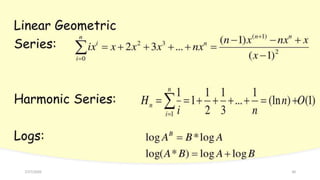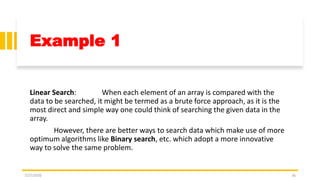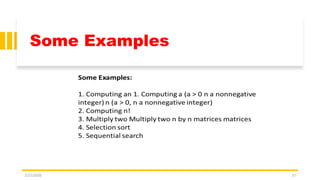Recursive algorithms
- 1. UNIT-I Analysis of the Recursive and Iterative Algorithms by Dr. N. Subhash Chandra, Professor, CVRCE. Source: Web resources and Computer Algorithms by Horowitz, Sahani & Rajasekaran 7/27/2020 1
- 2. ANALYSIS OF RECURSIVE ALGORITHMS BRUITE FORCE MEHOD STORE AND REUSE METHOD ALGORITHM CORRECTNESS CONTENTS 7/27/2020 2
- 3. Difference between Recursive and Iterative Algorithms PROPERTY RECURSION ITERATION Definition Function calls itself. A set of instructions repeatedly executed. Application For functions. For loops. Termination Through base case, where there will be no function call. When the termination condition for the iterator ceases to be satisfied. Usage Used when code size needs to be small, and time complexity is not an issue. Used when time complexity needs to be balanced against an expanded code size. Code Size Smaller code size Larger Code Size. Time Complexity Very high(generally exponential) time complexity. Relatively lower time complexity(generally polynomial- logarithmic). 7/27/2020 3
- 4. ANALYSIS OF RECURSIVE ALGORITHMS 7/27/2020 4
- 5. Recursive Algorithms Recursive sum Factorial Binary search Tower of Hanoi Permutation Generator 7/27/2020 5
- 8. Recursive Factorial Algorithm Form and solve the recurrence relation for the running time of factorial Algorithm and hence determine its big-O complexity: T(0) = c (1) T(n) = 1 + T(n - 1) (2) = 1+ 1 + T(n - 2) by substituting T(n – 1) in (2) = 1 +1 +1+ T(n - 3) by substituting T(n – 2) in (2) … = k + T(n - k) The base case is reached when n – k = 0 k = n, we then have: T(n) = n + T(n - n) = n + T(0) = n + c Therefore the method factorial is O(n) Algorithm factorial ( n) { if (n == 0) then return 1; else return n * factorial (n – 1); } 7/27/2020 8
- 9. Recursive Binary Search • The recurrence relation for the running time of the method is: T(1) = a if n = 1 (one element array) T(n) = T(n / 2) + b if n > 1 Algorithm BinarySearch (target,array, low, high) { if (low > high)then return ; else { middle = (low + high)/2; if (array[middle] == target)then return middle; else if(array[middle] < target)then return BinarySearch(target, array, middle + 1, high); else return BinarySearch(target, array, low, middle - 1); } } 7/27/2020 9
- 10. Analysis of Recursive Binary Search Expanding: T(1) = a (1) T(n) = T(n / 2) + b (2) = [T(n / 22) + b] + b = T (n / 22) + 2b by substituting T(n/2) in (2) = [T(n / 23) + b] + 2b = T(n / 23) + 3b by substituting T(n/22) in (2) = …….. = T( n / 2k) + kb The base case is reached when n / 2k = 1 n = 2k k = log2 n, we then have: T(n) = T(1) + b log2 n = a + b log2 n Therefore, Recursive Binary Search is O(log n) Without loss of generality, assume n, the problem size, is a multiple of 2, i.e., n = 2k 7/27/2020 10
- 11. Recursive Fibonacci number Algorithm T(n) = c if n = 1 or n = 2 (1) T(n) = T(n – 1) + T(n – 2) + b if n > 2 (2) We determine a lower bound on T(n): Expand : T(n) = T(n - 1) + T(n - 2) + b ≥ T(n - 2) + T(n-2) + b = 2T(n - 2) + b = 2[T(n - 3) + T(n - 4) + b] + b by substitute T(n - 2) in (2) 2[T(n - 4) + T(n - 4) + b] + b = 22T(n - 4) + 2b + b = 22[T(n - 5) + T(n - 6) + b] + 2b + b by substitute T(n - 4) in (2) ≥ 23T(n – 6) + (22 + 21 + 20)b . . . 2kT(n – 2k) + (2k-1 + 2k-2 + . . . + 21 + 20)b = 2kT(n – 2k) + (2k – 1)b The base case is reached when n – 2k = 2 k = (n - 2) / 2 Hence, T(n) ≥ 2 (n – 2) / 2 T(2) + [2 (n - 2) / 2 – 1]b = (b + c)2 (n – 2) / 2 – b = [(b + c) / 2]*(2)n/2 – b Récursive Fibonacci is exponentiel Algorithm Fibonacci (n) { // Recursively calculates Fibonacci number if( n == 1 || n == 2)then return 1; else return Fibonacci(n – 1) + Fibonacci(n – 2); } 7/27/2020 11
- 12. Tower of Hanoi Tower of Hanoi, is a mathematical puzzle which consists of three towers (pegs) and more than one rings is as depicted Rules The mission is to move all the disks to some another tower without violating the sequence of arrangement. A few rules to be followed for Tower of Hanoi are • Only one disk can be moved among the towers at any given time. • Only the "top" disk can be removed. • No large disk can sit over a small disk. 7/27/2020 12
- 13. TOH 7/27/2020 13
- 14. Algorithm TOH The steps to follow are − Step 1 − Move n-1 disks from source (X)to aux(Y) Step 2 − Move nth disk from source(X) to dest (Z) Step 3 − Move n-1 disks from aux (Y) to dest (Z) Algorithm TOH(n, x, y, z) // Move the top n discs from x to z, where x is source, Y auxiliary tower, Z is destination { if(n>=1)then { TOH(n-1, x, z, y); write( Move a disc from x to z); TOH(n-1, y, x, z); } } 7/27/2020 14
- 15. Tracing 3 Discs with algorithm 7/27/2020 15
- 16. Analysis of Recursive Towers of Hanoi Algorithm Expanding: T(1) = a (1) T(n) = 2T(n – 1) + b if n > 1 (2) = 2[2T(n – 2) + b] + b = 22 T(n – 2) + 2b + b by substituting T(n – 1) in (2) = 22 [2T(n – 3) + b] + 2b + b = 23 T(n – 3) + 22b + 2b + b by substituting T(n-2) in (2) = 23 [2T(n – 4) + b] + 22b + 2b + b = 24 T(n – 4) + 23 b + 22b + 21b + 20b by substituting T(n – 3) in (2) = …… = 2k T(n – k) + b[2k- 1 + 2k– 2 + . . . 21 + 20] The base case is reached when n – k = 1 k = n – 1, we then have: Therefore, The method hanoi is O(2n) 7/27/2020 16
- 20. Algorithm for Permutation generator 7/27/2020 20
- 21. Analysis of Permutation Generator 7/27/2020 21
- 22. ANALYSIS OF ITERATIVE ALGORITHMS 7/27/2020 22
- 23. 7/27/2020 23
- 24. 7/27/2020 24
- 25. 7/27/2020 25
- 26. 7/27/2020 26
- 27. 7/27/2020 27
- 28. 7/27/2020 28
- 29. 7/27/2020 29
- 30. 7/27/2020 30
- 31. 7/27/2020 31
- 32. • Proving an Algorithm’s Correctness • Brute Force Approach • Store and Reuse Method 7/27/2020 32
- 33. Proving an Algorithm’s Correctness Once an algorithm has been specified then its correctness must be proved. An algorithm must yield a required result for every legitimate input in a finite amount of time. 7/27/2020 33
- 34. Proving Technique for Algorithm correctness A common technique for proving correctness is to use mathematical induction because an algorithm’s iterations provide a natural sequence of steps needed for such proofs. The notion of correctness for approximation algorithms is less straightforward than it is for exact algorithms. The error produced by the algorithm should not exceed a pre-defined limit. 7/27/2020 34
- 35. Brute Force Approach • A brute force algorithm is a straightforward approach to solving a problem. It is usually based on problem statement and definitions • This approach consider all possible solutions. • It is based on trial and error where the programmer tries to merely utilize the computer’s fast processing power to solve a problem. • It is a naive approach adopted by most beginner programmers in the initial stages of solving a problem, however it might not be the most optimal approach, as it might increase both space and time complexity. Ex: TSP, Convex hull, Knapsack, Graph colouring, Closest distance etc 7/27/2020 35
- 36. Example 1 Linear Search: When each element of an array is compared with the data to be searched, it might be termed as a brute force approach, as it is the most direct and simple way one could think of searching the given data in the array. However, there are better ways to search data which make use of more optimum algorithms like Binary search, etc. which adopt a more innovative way to solve the same problem. 7/27/2020 36
- 38. Brute Force Solution Algorithm FindKey() { for i:=0 to 9 do { for j:=0 to 9 do{ for k:=0 to 9 do { for l:=0 to 9 do{ key:=char(i)+char(j)+char(k)+char(l); // character concatenation operations if iskey(key) then return key; } } } } } 7/27/2020 38
- 39. Store and Reuse method: In this algorithm the data is storing using MapReduce method and the algorithm's access the data through MapReduce method. 7/27/2020 39
- 40. Example store and reuse in algorithms 7/27/2020 40
- 41. Example: Store Method For example a remote sensing image data save in No-SQL database can be described as follows: step 1: Input the entire remote sensing image, the image contains more than one spatial-bands. step 2: Split the image into sub data according to bands. Step 3: For each sub data band, split it into lines Step 4: For each line, the pixels of line construct the value content. Through this algorithm we can save a remote sensing image into HBase and Hbase deploy on HDFS. 7/27/2020 41
- 42. Reuse Method • Content reuse is not one technique, but a collection of many techniques. • There are therefore several reuse algorithms each of which requires specific content structures in the subject and document domains. • The simplest content reuse technique is to cut and paste content from one source to another. This approach is quick and easy to implement, but it creates a host of management problems. So when people talk about content reuse they generally mean any and every means of reusing content other than cutting and pasting. 7/27/2020 42
- 43. Reuse method • Reusing content, then, really means storing a piece of content in one place and inserting it into more than one publication by reference. “Reusing” suggests that this activity is somewhat akin to rummaging through that jar of old nuts and bolts we have in the garage looking for one that is the right size to fix our lawnmower. • While we can do it that way, that approach is neither efficient nor reliable. The efficient and reliable approach involves deliberately creating content for use in multiple locations. When we deliberately create content for reuse, we need to place constraints on the content to be reused and the content that reuses it, and that puts we in the realm of structured writing. 7/27/2020 43








![Recursive Binary Search
• The recurrence relation for the running time of the method is:
T(1) = a if n = 1 (one element array)
T(n) = T(n / 2) + b if n > 1
Algorithm BinarySearch (target,array, low, high) {
if (low > high)then
return ;
else {
middle = (low + high)/2;
if (array[middle] == target)then
return middle;
else if(array[middle] < target)then
return BinarySearch(target, array, middle + 1, high);
else
return BinarySearch(target, array, low, middle - 1);
}
}
7/27/2020 9](https://image.slidesharecdn.com/recursivealgorithms-200728093138/85/Recursive-algorithms-9-320.jpg)
![Analysis of Recursive Binary Search
Expanding:
T(1) = a (1)
T(n) = T(n / 2) + b (2)
= [T(n / 22) + b] + b = T (n / 22) + 2b by substituting T(n/2) in (2)
= [T(n / 23) + b] + 2b = T(n / 23) + 3b by substituting T(n/22) in (2)
= ……..
= T( n / 2k) + kb
The base case is reached when n / 2k = 1 n = 2k k = log2 n, we then
have:
T(n) = T(1) + b log2 n
= a + b log2 n
Therefore, Recursive Binary Search is O(log n)
Without loss of generality, assume n, the problem size, is a multiple of 2, i.e., n = 2k
7/27/2020 10](https://image.slidesharecdn.com/recursivealgorithms-200728093138/85/Recursive-algorithms-10-320.jpg)
![Recursive Fibonacci number Algorithm
T(n) = c if n = 1 or n = 2 (1)
T(n) = T(n – 1) + T(n – 2) + b if n > 2 (2)
We determine a lower bound on T(n):
Expand : T(n) = T(n - 1) + T(n - 2) + b
≥ T(n - 2) + T(n-2) + b
= 2T(n - 2) + b
= 2[T(n - 3) + T(n - 4) + b] + b by substitute T(n - 2) in (2)
2[T(n - 4) + T(n - 4) + b] + b
= 22T(n - 4) + 2b + b
= 22[T(n - 5) + T(n - 6) + b] + 2b + b by substitute T(n - 4) in (2)
≥ 23T(n – 6) + (22 + 21 + 20)b
. . .
2kT(n – 2k) + (2k-1 + 2k-2 + . . . + 21 + 20)b
= 2kT(n – 2k) + (2k – 1)b
The base case is reached when n – 2k = 2 k = (n - 2) / 2
Hence, T(n) ≥ 2 (n – 2) / 2 T(2) + [2 (n - 2) / 2 – 1]b
= (b + c)2 (n – 2) / 2 – b
= [(b + c) / 2]*(2)n/2 – b Récursive Fibonacci is exponentiel
Algorithm Fibonacci (n) { // Recursively calculates
Fibonacci number
if( n == 1 || n == 2)then
return 1;
else
return Fibonacci(n – 1) + Fibonacci(n – 2);
}
7/27/2020 11](https://image.slidesharecdn.com/recursivealgorithms-200728093138/85/Recursive-algorithms-11-320.jpg)




![Analysis of Recursive Towers of Hanoi Algorithm
Expanding:
T(1) = a (1)
T(n) = 2T(n – 1) + b if n > 1 (2)
= 2[2T(n – 2) + b] + b = 22 T(n – 2) + 2b + b by substituting T(n – 1) in (2)
= 22 [2T(n – 3) + b] + 2b + b = 23 T(n – 3) + 22b + 2b + b by substituting T(n-2) in (2)
= 23 [2T(n – 4) + b] + 22b + 2b + b = 24 T(n – 4) + 23 b + 22b + 21b + 20b by substituting
T(n – 3) in (2)
= ……
= 2k T(n – k) + b[2k- 1 + 2k– 2 + . . . 21 + 20]
The base case is reached when n – k = 1 k = n – 1, we then have:
Therefore, The method hanoi is O(2n)
7/27/2020 16](https://image.slidesharecdn.com/recursivealgorithms-200728093138/85/Recursive-algorithms-16-320.jpg)


























